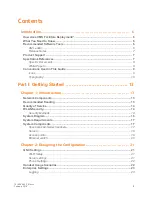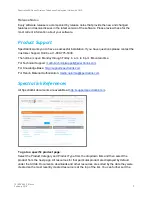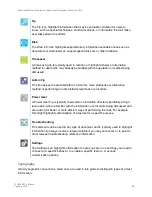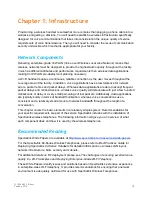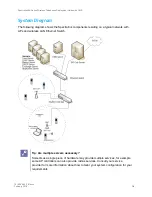
Spectralink 84-Series Wireless Telephones Deployment Guide with CMS
721-0048-000_B.docx
February 2018
14
Quality of Service
The Spectralink 84-Series handset uses Wi-Fi Multimedia (WMM), WMM Power Save and
WMM Admission Control mechanisms to deliver enterprise-grade Quality of Service (QoS). The
use of WMM and WMM Power Save are required. You can disable WMM Admission Control in
the access points if needed. However the use of all three WMM specifications is highly
recommended by Spectralink and is the default operating mode of the handset.
Refer to
Best Practices Guide to Network Design Considerations for Spectralink Wireless
Telephones.
AP Configuration Guides show you how to correctly configure access points and WLAN
controllers (if applicable) and identify the optimal settings that support Spectralink 84-Series
handsets. The guides can be found at the View Certified page.
WLAN Security
Wireless technology does not provide any physical barrier from malicious attackers since radio
waves penetrate walls and can be monitored and accessed beyond the wall even from outside
the facility. The extent of security measures used is typically proportional to the value of the
information accessible on the network. The security risk for VoWLAN is not limited to the typical
wired telephony concerns of eavesdropping on telephone calls or making unauthorized toll calls,
but is equivalent to the security risk of the data network that connects to the APs. Several
different security options are supported on Spectralink 84-Series Wireless Telephones.
Determining the proper level of security should be based on identified risks, corporate policy
and an understanding of the pros and cons of the available security methods.
Security Methods
The security methods available for Spectralink Wireless Telephones are industry standard
implementations used in typical Enterprise VoIP installations. The scope of this document does
not include a complete analysis of security methods. Refer to
Best Practices for Wireless
Security
for detailed information.
Wireless
Security
Method
Security in
Enterprise
Environments
Audio
Ease of Configuration and Other General Information
WEP
Poor
Excellent
Easy to administer, little processing overhead, adequate
security for many home Wi-Fi networks. Easily
compromised with hacking tools readily available on the
internet. Every phone can decrypt every other phone’s
data. Still in use on some older enterprise networks.
WPA-PSK
Acceptable
Excellent to
Good
Acceptable security for many small business Wi-Fi
networks. Each phone negotiates a key (see TKIP
below) with the AP so phones can’t decrypt each other’s
data, although a sophisticated hacking device that



